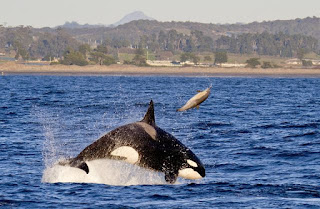——— orcinus orca
COMMON NAME: Orca (Killer Whale)
SCIENTIFIC NAME: Orcinus orca
TYPE: Mammals
DIET: Carnivores
GROUP NAME: Pod
AVERAGE LIFESPAN IN THE WILD: 50 to 80 years
SIZE: 23 to 32 ft
WEIGHT: Up to 6 tons
ABOUT THE ORCA
Orcas, or killer whales, are the largest of the dolphins and one of the world's most powerful predators. They feast on marine mammals such as seals, sea lions, and even whales, employing teeth that can be four inches long. They are known to grab seals right off the ice. They also eat fish, squid, and seabirds.
Hunting and Communication
Though they often frequent cold, coastal waters, orcas can be found from the polar regions to the Equator.
Orcas hunt in deadly pods, family groups of up to 40 individuals. There appears to be both resident and transient pod populations of orcas. These different groups may prey on different animals and use different techniques to catch them. Resident pods tend to prefer fish, while transient pods target marine mammals. All pods use effective, cooperative hunting techniques that some liken to the behavior of wolf packs.
Whales make a wide variety of communicative sounds, and each pod has distinctive noises that its members will recognize even at a distance. They use echolocation to communicate and hunt, making sounds that travel underwater until they encounter objects, then bounce back, revealing their location, size, and shape.
Reproduction and Conservation
Orcas are protective of their young, and other adolescent females often assist the mother in caring for them. Mothers give birth every three to ten years, after a 17-month pregnancy.
Orcas are immediately recognizable by their distinctive black-and-white coloring and are the intelligent, trainable stars of many aquarium shows. Orcas have never been extensively hunted by humans.
Another Fact
1. Though called killer whales, orcas aren't whales; they are the largest dolphin species.
2. In Argentina, orcas hurl themselves on-shore to grab sea lion pups.
3. In the Antarctic, pod members cooperate to make large waves that wash seals from ice floes.
4. Whalers call the orca the "killer of the whales." It preys on sperm, gray, fin, humpback, and other whales.


Comments
Post a Comment